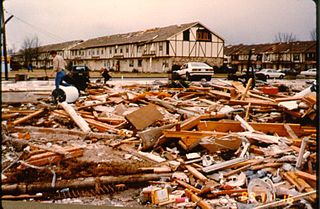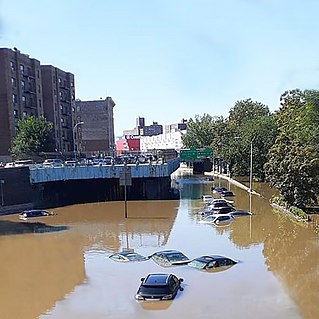
Huntsville is a city in Madison County, Limestone County, and Morgan County, Alabama, United States. It is the county seat of Madison County. Located in the Appalachian region of northern Alabama, Huntsville is the most populous city in the state.

Tuscaloosa is a city in and the seat of Tuscaloosa County in west-central Alabama, United States, on the Black Warrior River where the Gulf Coastal and Piedmont plains meet. Alabama's fifth-largest city, it had an estimated population of 101,129 in 2019. It was known as Tuskaloosa until the early 20th century. It is also known as the Druid City because of the numerous water oaks planted in its downtown streets since the 1840s.

A destructive tornado outbreak struck a wide swath of the Southern and Eastern United States as well as Canada on November 15 and 16, 1989. It produced at least 40 tornadoes and caused 30 deaths as a result of two deadly tornadoes. The most devastating event was the Huntsville, Alabama F4 tornado, which killed 21 on the afternoon of November 15. Nine more fatalities occurred at a single elementary school by an F1 tornado on November 16 in Newburgh, New York, although further survey revealed that this might have been a downburst instead. This outbreak also produced the most tornadoes in a single day in New Jersey. Several other significant tornadoes were reported across 15 states.
The article covers the Hurricane Katrina effects by region, within the United States and Canada. The effects of Hurricane Katrina, in late August 2005, were catastrophic and widespread. It was one of the deadliest natural disasters in U.S. history, leaving at least 1,836 people dead, and a further 135 missing. The storm was large and had an effect on several different areas of North America.

Hurricane Danny was the only hurricane to make landfall in the United States during the 1997 Atlantic hurricane season, and the second hurricane and fourth tropical storm of the season. The system became the earliest-formed fifth tropical or subtropical storm of the Atlantic season in history when it attained tropical storm strength on July 17, and held that record until the 2005 Atlantic hurricane season when Tropical Storm Emily broke that record by several days. Like the previous four tropical or subtropical cyclones of the season, Danny had a non-tropical origin, after a trough spawned convection that entered the warm waters of the Gulf of Mexico. Danny was guided northeast through the Gulf of Mexico by two high pressure areas, a rare occurrence in the middle of July. After making landfall on the Gulf Coast, Danny tracked across the southeastern United States and ultimately affected parts of New England with rain and wind.
On March 21–22, 1932, a deadly tornado outbreak struck the Midwestern and Southern United States. At least 38 tornadoes—including 27 killers and several long-lived tornado families—struck the Deep South, killing more than 330 people and injuring 2,141. Tornadoes affected areas from Mississippi north to Illinois and east to South Carolina, but Alabama was hardest hit, with 268 fatalities; the outbreak is considered to be the deadliest ever in that U.S. state, and among the worst ever in the United States, trailing only the Tri-State tornado outbreak in 1925, with 747 fatalities, and the Tupelo–Gainesville outbreak in 1936, with 454 fatalities. The 1932 outbreak is believed to have produced 10 violent tornadoes, eight of which occurred in Alabama alone.

This page documents notable tornadoes and tornado outbreaks worldwide in 2009. Strong and destructive tornadoes form most frequently in the United States, Argentina, Brazil, Bangladesh, and Eastern India, but can occur almost anywhere under the right conditions. Tornadoes also develop occasionally in southern Canada during the Northern Hemisphere's summer and somewhat regularly at other times of the year across Europe, Asia, Argentina, Australia and New Zealand. Tornadic events are often accompanied by other forms of severe weather, including strong thunderstorms, strong winds, and hail. In the U.S., there were 1,304 reports of tornadoes received by the Storm Prediction Center (SPC), and 1,159 tornadoes were confirmed to have taken place. Worldwide, 73 fatalities were caused by tornadoes; 22 in the United States, 20 in India, 11 in Argentina, eight in the Philippines, four each in Canada and Brazil, two in Greece and one each in Serbia and Russia.

The tornado outbreak of April 9–11, 2009 was a tornado outbreak that affected large portions of the Southern United States on April 9–11, 2009. At least 5 people were killed by tornadoes including three in Mena, Arkansas and two in Murfreesboro, Tennessee just south of Nashville. A total of 85 tornadoes were confirmed over the two days. Three people were killed in Texas due to wildfires caused by strong winds stemming from the same storm system. This event is sometimes referred to as the Good Friday tornado outbreak of 2009.

This page documents the tornadoes and tornado outbreaks of 1989, primarily in the United States. Most tornadoes form in the U.S., although some events may take place internationally. Tornado statistics for older years like this often appear significantly lower than modern years due to fewer reports or confirmed tornadoes.

The tornado outbreak of April 22–25, 2010 was a multi-day tornado outbreak across a large portion of the Southern United States, originally starting in the High Plains on April 22, 2010 and continuing through the Southern Plains on April 23, and the Mississippi and Tennessee Valleys on April 24. The most severe activity was on April 24, particularly in Mississippi. The outbreak was responsible for ten tornado-related fatalities on April 24, all in Mississippi from a single supercell that crossed the entire state.

The 2011 Super Outbreak was the largest, costliest, and one of the deadliest tornado outbreaks ever recorded, taking place in the Southern, Midwestern, and Northeastern United States from April 25–28, 2011, leaving catastrophic destruction in its wake. Over 175 tornadoes struck Alabama, Mississippi, and Tennessee, which were the most severely damaged states. Other destructive tornadoes occurred in Arkansas, Georgia, Kentucky, Louisiana, New York, and Virginia, with storms also affecting other states in the Southern and Eastern United States. In total, 360 tornadoes were confirmed by NOAA's National Weather Service (NWS) and Government of Canada's Environment Canada in 21 states from Texas to New York to southern Canada. Widespread and destructive tornadoes occurred on each day of the outbreak. April 27 was the most active day, with a record 216 tornadoes touching down that day from midnight to midnight CDT. Four of the tornadoes were rated EF5, which is the highest ranking on the Enhanced Fujita scale; typically these tornadoes are recorded no more than once a year.

Search and rescue in the United States involves a wide range of organizations that have search and rescue responsibilities.

A devastating EF5-rated multiple-vortex tornado struck Joplin, Missouri on the evening of Sunday, May 22, 2011. Part of a larger late-May tornado outbreak, the tornado reached a maximum width of nearly one mile (1.6 km) during its path through the southern part of the city. This particular tornado was unusual in that it intensified and grew in size at a very fast rate. The tornado tracked eastward across the city, and then continued eastward across Interstate 44 into rural portions of Jasper and Newton counties. It was the third tornado to strike Joplin since May 1971.

A relatively widespread, damaging, and deadly tornado outbreak struck the central and southern United States in late April 2014. The storm complex responsible for the outbreak produced multiple long-track tornadoes – seven were deadly, causing 35 fatalities. One additional death occurred in Florida, due to severe flooding associated with this system.

A significant and deadly severe weather event that affected the Southeastern United States on March 3, 2019. Over the course of 6 hours, a total of 41 tornadoes touched down across portions of Alabama, Georgia, Florida, and South Carolina. The strongest of these was an EF4 tornado that devastated rural communities from Beauregard, Alabama through Smiths Station, Alabama to Talbotton, Georgia, killing 23 people and injuring at least 100 others. Its death toll represented more than twice the number of tornado deaths in the United States in 2018 as well as the deadliest single tornado in the country since the 2013 Moore EF5 tornado. An EF3 tornado also destroyed residences to the east of Tallahassee in Leon County, Florida, and was only the second tornado of that strength in the county since 1945. Several other strong tornadoes occurred across the region throughout the evening of March 3 and caused significant damage. A large number of EF0 and EF1 tornadoes also touched down.

This page documents the tornadoes and tornado outbreaks of 1953, primarily in the United States. Most tornadoes form in the U.S., although some events may take place internationally. Tornado statistics for older years like this often appear significantly lower than modern years due to fewer reports or confirmed tornadoes. This was the first year to record an F5 tornado as well as one of the deadliest tornado seasons in official U.S. records, which go back to 1950.

The following is a list of weather events that occurred in 2021. The year began with La Niña conditions. There were several natural disasters around the world from various types of weather, including blizzards, cold waves, droughts, heat waves, tornadoes, and tropical cyclones. In December, powerful Typhoon Rai moved through the southern Philippines, killing 410 people and becoming the deadliest single weather event of the year. The costliest event of the year, and the costliest natural disaster on record in the United States, was from a North American cold wave in February 2021, which caused $196.4 billion (USD) in damage; the freezing temperatures and widespread power outages in Texas killed hundreds of people. Another significant natural disaster was Hurricane Ida, which struck southeastern Louisiana and later flooded the Northeastern United States, resulting in $70 billion (USD) in damage. December saw two record-breaking tornado outbreaks, only four days apart from each other.

On June 24, 2021, at approximately 1:22 a.m. EDT, Champlain Towers South, a 12-story beachfront condominium in the Miami suburb of Surfside, Florida, United States, partially collapsed, causing the death of 98 people. Four people were rescued from the rubble, but one died of injuries shortly after arriving at the hospital. Eleven others were injured. Approximately thirty-five were rescued the same day from the un-collapsed portion of the building, which was demolished 10 days later.
The following is a list of weather events that occurred on Earth in the year 2022. The year began with a La Niña. The most common weather events to have a significant impact are blizzards, cold waves, droughts, heat waves, wildfires, floods, tornadoes, and tropical cyclones.

From April 4–5, 2022, a mesoscale convective system and numerous discrete supercells produced a swath of severe weather and several tornadoes in the Southeastern United States, including several strong, long tracked tornadoes. An EF3 tornado damaged or destroyed several homes in Bonaire, Georgia while a large EF3 tornado prompted a tornado emergency for Allendale and Sycamore, South Carolina. A violent EF4 tornado in Black Creek, Georgia resulted in one fatality as it destroyed several neighborhoods and another large EF3 tornado caused widespread heavy tree damage northeast of Ulmer, South Carolina. More severe storms occurred across a large portion of the Southeast ahead of a cold front on April 6–7, with more tornadoes reported in South and Central Georgia and further south into Florida, all of which were weak. Along with the one tornadic death, falling trees killed one person each in Louisiana and Texas.
















